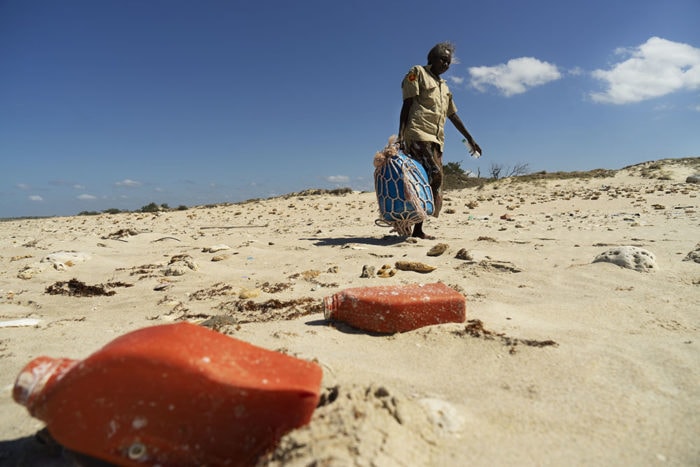Toxic tides: the rubbish washing up in East Arnhem Land

ON A LONESOME, seemingly infinite stretch of shoreline more than 100km away from any significant outpost, two Aboriginal rangers trawl through a pile of marine debris. Other than their own footprints, the only obvious signs of life the Yirralka rangers see are a sun-bleached kangaroo skull, crabs, hawks, and the occasional pile of buffalo droppings.
But at this Yolngu-owned area of East Arnhem Land, on the Northern Territory edge of the Gulf of Carpentaria, something is significantly wrong. The beach is far from untouched. It’s littered with thousands of multicoloured nets, ropes, thongs, wrappers and bottles.
Some of the rubbish is easy to spot – barnacle-coated fuel drums or buoys, while some remains harder to see – tiny shards of broken plastic containers and lids. It’s all destructive. At the most recent count, Territory researchers estimated up to a tonne of waste had washed up per kilometre along this remote coastline last year, most of it from Indonesian waters. It’s an environmental disaster knocking, wave after wave, at Australia’s doorstep.
AS A LITTLE BOY, Mandaka ‘Djami’ Marika would wander for kilometres on the white sands of his country on the Gove Peninsula, looking for a feed of turtle or stingray. It was out here his elders taught him how to rig up a turtle spear for hunting, and where he watched the old ladies gather mud mussels for tucker.
And now, decades later, Mandaka picks up a plastic bottle off the same shoreline, located not more than a few kilometres from the Yolngu community of Yirrkala, and shakes his head. “When I was growing up we used to walk on this beach,” says Mandaka, a senior Rirratjingu traditional owner and the managing director of Dhimurru Aboriginal Corporation. “We would enjoy walking because there was nothing to worry about; it was all clean,” he says. “This is one of the spots that’s been taken over by rubbish. Plastic, plastic, plastic. There’s so much plastic…in the end, plastic will take over. Plastic in the land, plastic in the sea, plastic everywhere.”
Nearby Indonesia is one of the planet’s worst plastic polluters, second only to China; it also harbours the world’s second most prolific fishing industry. As the only area of sea in Indonesia where trawling is legally permitted, the Arafura Sea contains the nation’s largest fisheries and some of the largest in South-East Asia. The sea is also a known global hotspot for illegal trawling by both Indonesian and foreign operators. Thousands of boats trawl the Arafura each day, directly adjacent to one of the most sparsely populated corners of the NT.
Darwin-based marine scientist Professor Karen Edyvane, of Charles Darwin University, has been monitoring rates of ocean-based debris in the NT for 15 years. She says that with such intensive fishing so close by, “it was only a matter of time before we started seeing the impact on northern Australia”.
“Indonesia has a population of more than 260 million people, and it’s one of the most seafood-dependent nations in the world,” she says. “A lot of people depend on ocean resources for their food security and also livelihood…so we’re looking at some incredibly heavily fished waters.”
The rubbish, much of it jettisoned from fishing boats, only began appearing in force on Arnhem Land beaches in the late 1990s. But once it started, there was no reversing the flow. Karen and other researchers who have been monitoring the influx of rubbish on a stretch of coast at Cape Arnhem say the volume of debris has doubled since 2008.
By their stats, along the 3.9km stretch, the rubbish has included a staggering average of 2075 thongs, 1967 bottle caps and 1341 plastic bottles annually. This doesn’t include the hundreds of bags, lighters, buoys and toothbrushes being picked up year after year.

Yirralka ranger Djurambil Mununggurr lugs some marine debris back to the rangers’ ute on a remote beach near Garrthalala, Arnhem Land. (Image credit: Keri Megelus)
This is an extract from Issue 146 of Australian Geographic now on sale.




